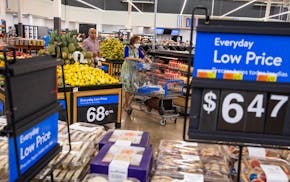The next decade could bring downtown Minneapolis a marquee outdoor ice rink, a Michelin star, consistent skyway hours and thousands more residents if the Downtown Council's 10-year plan comes to fruition.
The business organization unveiled its vision for the future of downtown Monday, including ambitious goals to transform Minneapolis' urban core by 2035 to meet new demands and desires. That starts with filling the gaps office workers left when remote and hybrid work became popular during the COVID-19 pandemic.
Proposals in the 131-page "Downtown by Design" report range from massive redevelopment aspirations — including the transformation of the riverfront post office — to more modest improvements such as the removal of pavement and grating around trees on Nicollet Mall.
The timelines, progress and feasibility also vary widely: While some projects, like the redesign of 1st Avenue N., are already under way, other ideas like the outdoor ice rink have few concrete details.
The plan is perhaps the most extensive in the string of recent strategies aiming to reinvent the downtown. Last month, Mayor Jacob Frey released the city's plans to approach downtown revitalization, and the nonprofit Minneapolis Foundation late last year published a report suggesting ways to transform core neighborhoods.
"There has never been more energy and enthusiasm about downtown than there is right now," said Minneapolis Downtown Council President and CEO Adam Duininck. "That's the good news. And I think the challenge is: How do we gather up all that energy, resources and that momentum and aim it all at the same direction?"
Though cities across the country have faced commercial real estate challenges since the pandemic, Duininck said Minneapolis has seen slower returns to offices compared to peer regions. Until this year, he added, the city was also lagging in other metrics measuring hotel occupancy and business travel.
"What I really believe is: We've started to see indicators head in the right direction," Duininck said. "We've started to see progress. But we still have a long way to go."
Focus on fundamentals
The Downtown Council's strategy focuses on four main tenets: Neighborhood cultivation, foundational safety, hassle-free systems and irresistible vibe.
Duininck said he considers the middle two pillars fundamentals for many of the grander ideas raised in the plan.
The report advocates for the continued buildout of downtown's emergency response network with a well-staffed police force and alternative resources to support it. A key to this approach is the new safety communications center downtown in Minneapolis police's First Precinct. Residents, workers and visitors can report issues to the center if they're unsure whether 911 is the right response, and dispatch will figure out which agency is best suited to address it.
In the spirit of making downtown easier to navigate, the Downtown Council is asking property owners and city leaders to once again consider coordinating skyway hours and management. Unlike St. Paul, Minneapolis' skyways are mostly privately run, which has led to a hodgepodge of hours, rules and security.
The council also wants to make it easier to do business downtown, advocating for more streamlined permitting for redevelopment projects and events.
Live, work and play
The report echoes developers and civic leaders who have been saying more mixed-use spaces will increase vibrancy across downtown. That means expanding housing options and commercial offerings in all neighborhoods.
To help accomplish the former, the plan set a goal of converting 3 million square feet of commercial space into housing. Though much of that growth would likely happen in the central business district, the council also considers neighborhoods like the North Loop, Elliot Park and Loring Park part of downtown.
That total downtown area is home to about 58,000 residents, a number which the council hopes to eventually grow to 100,000.
In a statement Monday, the president of the board of the Downtown Minneapolis Neighborhood Association (DMNA), which represents downtown residents and businesses, said the group planned to review the council's plan in detail.
"We are disappointed, however, that the DMNA was not invited to participate in the plan's development, but we are optimistic that we will be involved in the implementation phase," Board President Dianne Walsh wrote. "All parties must work together to shape a vibrant and inclusive future for our downtown community."
On the commercial side, Duininck said he thinks making Nicollet Mall a pedestrian-only thoroughfare will be a priority for the council.
"We want to have it feel like as much of a park as it is a pedestrian experience," connecting the Loring Park side of downtown to the riverfront, he said.
There, the council identified several other potential redevelopments, including the post office, which "may take a literal act of Congress" to happen, the report said.
That's not to say downtown's current mainstays will go ignored. Target Center, for instance, has been in the spotlight as ownership of its NBA and WNBA franchises went to arbitration earlier this month. The report said the council has "every intention of continuing to build on that major venue success, including any facility changes necessary to keep the Timberwolves and Lynx downtown."
New programming and venues like the proposed skating rink would aim to give people more reasons to visit downtown when major events aren't happening. The report suggests embracing Minnesota winters with events like Holidazzle and the Great Northern Festival.
The council said it also plans to pick up the long-discussed mission to bring Minnesota a Michelin star, a task that might involve annual funding to bring the guide's reviewers to town. It hopes to attract businesses, too, by partnering with the economic development nonprofit Greater MSP to bolster recruitment efforts.
Next steps
John Rent, a commercial real estate lender who serves on the Downtown Council's board, said he thinks it's important to recognize the goals of past strategic plans the city has achieved.
"Ten years ago, we envisioned dramatically increasing downtown's residential population and development of a new Vikings stadium and surrounding mixed-use neighborhood, both among the biggest successes downtown experienced over that time period," he wrote in an email. "Past successes prove the power of public-private partnerships and how we will achieve the ambitious goals in the 'Downtown by Design' plan."
Duininck said while the council hasn't calculated a cost for the plan, he acknowledged it will take substantial public and private investments.
"I think it would be easy to get to billions," he said.
About 200 people helped draft the strategy, including representatives from government, major corporations, sports teams, the hospitality sector and nonprofits.
The Downtown Council's next step is to engage even more people. Residents, workers and visitors can fill out a survey on the organization's website. Duininck said the council is also planning to convene work groups that will meet regularly on specific projects or issues.
"Downtown has changed quite a bit in the last 10 years," said John Marshall of Xcel Energy, the Downtown Council's incoming board chair. "I think that the plan lays out a nice clear roadmap — with some fluidity — as downtown continues to grow and change."
Minnesota's med spa industry rises in popularity — and with little regulation

Ramstad: Readers say Walmart won't be paying the ultimate price of Trump's tariffs

How Minnesota businesses can spot and prevent invoice fraud
No place for cryptocurrency in retirement portfolios

